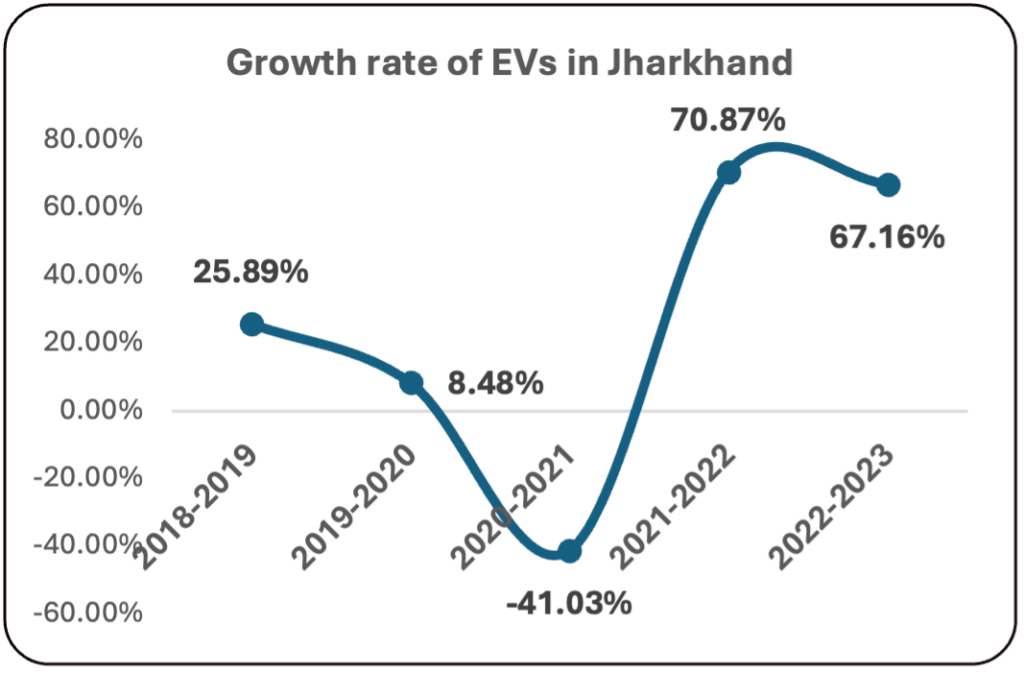Shrishty Pallav |
September 9 marks World Electric Vehicle Day with the theme for 2024 being #DriveChange for a better world. Sustainable mobility has increasingly become a vital component of achieving India’s national and international climate goals. The Government of India has pledged to achieve net-zero emissions by 2070 in United Nations Climate Change Conference in Glasgow (COP-26) in 2021. The Government has also committed to reduce the carbon emissions intensity of the country’s gross domestic product by 45%, relative to 2005 levels, by 2030. E-mobility solutions are critical for realising these goals and the role of states in adopting and mainstreaming electric vehicles in their transport systems remains paramount.
The Government of India has set a target to achieve 30 percent electrification of the country’s vehicle fleet by 2030 and has introduced several incentives and policies to support the growth of the EV industry. The government is constantly encouraging the production of EVs, adoption of hydrogen fuel, and embracing of changing technologies in the light of meeting global commitments on climate change and sustainable development. About 28 Indian states have notified their EV policies outlining targets, incentives for achieving electrification of the fleet.
Case of Jharkhand
Jharkhand, a mineral rich state, has its own ‘Electric Vehicle Policy 2022’, which aims to bolster EV manufacturing and sales in the state through fiscal and non-fiscal incentive mechanisms. There are 62,837 registered e-vehicles in Jharkhand till date and 256 public charging stations. Jharkhand has a low overall EV penetration rate of 1.30%. However, the sales of EVs have been consistently growing. Across the category of vehicles, 22,942 electric 2-wheelers have been sold, while electric 3-wheelers show higher sales with 38,357 units sold. Four wheelers remain low in terms of sales with only 1,475 units sold till August 2024.


Source: VAHAN Dashboard https://vahan.parivahan.gov.in/vahan4dashboard/vahan/vahan/view/reportview.xhtml
Jharkhand’s EV policy is a step in the right direction, however, there remains ample scope of improving the policy for reflecting the dynamic nature of the domain as well as bringing on ground changes and awareness. Jharkhand needs to ramp up its EV adoption along with the overall ecosystem around it for achieving the target of 10% electrification by 2027, as laid out in the policy.
Challenges in Jharkhand’s E-Mobility Adoption
There are many structural and functional challenges in the path to electric mobility system in Jharkhand. Even though the policy mentions establishing Jharkhand as a hub for EV manufacturing, there has been scant progress in this area. Another critical barrier to the adoption of EVs in Jharkhand is the inadequate charging infrastructure. There are public charging stations only in the major cities of Ranchi, Dhanbad, and Jamshedpur and the rural areas have very limited access to charging points.
Jharkhand, like many states in India, faces issues related to electricity supply and grid stability, especially in rural areas. EVs rely on stable electricity for charging, and intermittent power supply can hinder the adoption of e-mobility. In many parts of Jharkhand, power cuts are frequent, raising concerns about whether the state’s electrical grid is prepared for the increased demand that widespread EV adoption would bring. The EV policy also requires mid-course correction for incorporating mandates and provisions which ensures timely adoption of EVs, defined timelines for targets, robust feedback mechanism which it currently lacks.
Opportunities for E-Mobility in Jharkhand
- Boosting Local Manufacturing
Jharkhand has the potential to become a manufacturing hub for electric vehicle components, batteries, and charging equipment. With its rich mineral resources Jharkhand could play a crucial role in the EV supply chain and future energy security of the nation. Jharkhand has emerged as a significant hub of critical minerals such as lithium, copper, graphite etc, boasting the highest presence of 12 critical minerals, while Odisha follows closely with 8 critical minerals crucial for India’s energy transition (CEED, 2024). The state could also utilise existing automobile industry such as Jamshedpur Adityapur auto cluster which has more than 800 auto ancillary units to start a pilot electric vehicles manufacturing unit.
- Introducing Zero Emission Trucking
Jharkhand’s strong industrial base in mining and heavy industry leads to huge usage of heavy duty trucks which is a major source of emissions. As of 2020, Heavy Duty Trucks (HDTs) contributed around 40% of total on-road carbon emissions in India (Kumar et al., 2022). Government of India has issued Bharat Zero Emission Trucking (ZET) Policy Advisory in August 2024 which lays down 30 policy interventions for accelerating ZET adoption. Jharkhand must use this advisory to create its own tailor-made policy on ZET enabling reduced emissions through the mining industry.
- Employment Generation
The growth of e-mobility would stimulate job creation in Jharkhand. This includes opportunities in manufacturing, maintenance, installation of charging infrastructure, and software development for EV technologies. Vocational training programs focused on EV technologies could be created for fostering the local workforce transition into the sector.
- Renewable Energy Integration
Jharkhand is proving to be a stalwart of sustainable pathways for combating climate change and its adverse impacts. It is one of the first states to form a Task Force on Sustainable Just Transition which has sustainable mobility transition as one of its thematic areas. The integration of renewable energy with e-mobility is a promising opportunity for the state. Charging stations powered by solar panels, for instance, could reduce the load on the grid while promoting green energy.
Conclusion & Way Forward
Jharkhand’s transition to e-mobility represents a significant step toward a more sustainable and economically vibrant future. However, to fully realize the potential of this transition, the state needs to address several key challenges, including building sufficient charging infrastructure, reducing the high cost of EVs, and updating policy.
Despite these challenges, the opportunities for Jharkhand in the e-mobility sector are vast. By leveraging its industrial base, focusing on renewable energy integration, and fostering collaboration between the public and private sectors, Jharkhand can contribute immensely to India’s e-mobility revolution.
References:
- Singh, Yadav, A. April,2024. Assessing the scale of zero-emission truck deployment required for meeting India’s net-zero goal. https://theicct.org/wp-content/uploads/2024/04/ID-58-%E2%80%93-India-ZET_final.pdf
- Kumar et al., 2022. Decarbonising India’s Road Transport : A Meta Analysis of Road Transport Emission Models. https://theicct.org/wp-content/uploads/2022/05/Meta-study-India-transport_final.pdf
- Press Information Bureau, Government of India. 2022, August 3. Cabinet approves India’s Updated Nationally Determined Contribution to be communicated to the United Nations Framework Convention on Climate Change [Press release]. https://pib.gov.in/PressReleasePage.aspx?PRID=1847812
- CEED. 2024. Critical Minerals for Energy Transition: A Catalyst for making Jharkhand Future-Ready. Centre for Environment and Energy Development, New Delhi. https://doi.org/10.5281/ zenodo.11635886
- https://pib.gov.in/PressReleasePage.aspx?PRID=1795071


